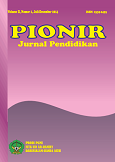DEVELOPMENT OF DIGITAL COMICS MEDIA BASED ON I-SPRING ON PANCASILA VALUES MATERIAL FOR GRADE IV SDN 2 KUTOANYAR, TULUNGAGUNG REGENCY
DOI:
https://doi.org/10.22373/pjp.v13i3.25268Abstract
This study aims to develop and test the validity, practicality, and effectiveness of I-Spring-based Digital Comic Media on Pancasila Education subjects in class IV SDN 2 Kutoanyar. By using the ADDIE development model which consists of five main stages: Analysis, Design, Development, Implementation, and Evaluation, this research begins with problem identification through observations and interviews at the school. The material was developed using Microsoft PowerPoint application and converted into an interactive multimedia format with i-Spring. Media validation was carried out by material experts and media experts, giving 88% and 92% marks respectively, which accumulated to 90%, indicating that the media was very valid. Implementation involved limited trials and extensive trials involving students and teachers, showing excellent practicality with an accumulative score of 93.5% from student and teacher responses, indicating the media was very practical and did not require revision. The effectiveness test through evaluation questions (Post Test) showed positive results, with the average score of students reaching 90.4%, exceeding the Minimum Completeness Criteria (KKM) of ≥75, which means that this media is very effective in increasing students' understanding and enthusiasm for Pancasila values material. Thus, I-Spring-based Digital Comic Media can be recommended as a valid, practical, and effective learning media to be applied in Civics education in elementary schools.
Keywords: Digital Comic Media for PPKn Learning Development Model ADDIE.
References
Amelia, P., & Purwaningsih, H. (2021). Desain Komik Digital Cerita Rakyat Desa Arjowilangun. Brikolase : Jurnal Kajian Teori, Praktik Dan Wacana Seni Budaya Rupa, 13(2). https://doi.org/10.33153/brikolase.v13i2.3829
Apriliani, M. A., Maksum, A., Wardhani, P. A., Yuniar, S., & Setyowati, S. (2021). Pengembangan media pembelajaran PPKn SD berbasis Powtoon untuk mengembangkan karakter tanggung jawab. Jurnal Ilmiah Pendidikan Dasar, 8(2). https://doi.org/10.30659/pendas.8.2.129-145
Daniyati, A., Saputri, I. B., Wijaya, R., Septiyani, S. A., & Setiawan, U. (2023). Konsep Dasar Media Pembelajaran. 1(1), 282–294.
Ernawati, Y., Rufii, & Waluyo, D. A. (2020). Komik Digital Ekonomi Untuk Generasi Milenial. Jurnal Education and Development Institut Pendidikan Tapanuli Selatan, 8(2).
Handayani, S. (2023). Integrasi Metode Pembelajaran Sosiodrama dan Media Komik Bergambar dalam Pembelajaran Menulis Teks Sesorah Sesuai Unggah-Ungguh Bahasa Jawa. Jurnal Pendidikan Indonesia, 4(1). https://doi.org/10.36418/japendi.v4i1.1535
Herni, Rahmawati, N., & Wiyatmo, Y. (2021). Pengembangan media pembelajaran interaktif berbasis software ispring suite 9 untuk meningkatkan minat belajar dan bemandirian Belajar peserta didik kelas X pada mata pelajaran fisika. Jurnal Pendidikan Fisika, 8(2).
Sugiyono. (2008). Metode Penelitian Kuantitatif. kualitatif dan R&D. Bandung: Alfabeta.
Sumantri, M. S., & Rachmadtullah, R. (2016). The effect of learning media and self regulation to elementary students’ history learning outcome. Advanced Science Letters, 22(12), 4104–4108. https://doi.org/10.1166/asl.2016.8140
Tambunan, H., & Napitupulu, E. (2016). Effectiveness of Interactive Multimedia Based Learning Model in Engineering Mechanics. International Education Studies, 9(10), 155–162. https://doi.org/10.5539/ies.v9n10p155
Vaughan, T. (2011). Multimedia Making it work ;8th Edition. New York: McGraw-Hill.
Wahyuni, I. (2018). Pemilihan Media Pembelajaran. Jurnal Pendidikan, 1(1).
Downloads
Published
Issue
Section
License
- Authors retain copyright and grant the journal right of first publication with the work simultaneously licensed under a Creative Commons Attribution License that allows others to share the work with an acknowledgment of the work's authorship and initial publication in this journal.
- Authors are able to enter into separate, additional contractual arrangements for the non-exclusive distribution of the journal's published version of the work (e.g., post it to an institutional repository or publish it in a book), with an acknowledgment of its initial publication in this journal.
- Authors are permitted and encouraged to post their work online (e.g., in institutional repositories or on their website) prior to and during the submission process, as it can lead to productive exchanges, as well as earlier and greater citation of published work (See The Effect of Open Access).

